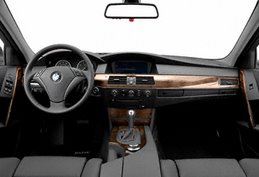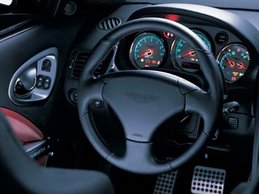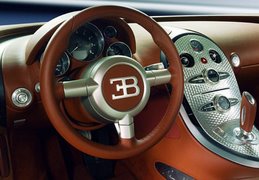 2008 Subaru Impreza WRX STI
2008 Subaru Impreza WRX STI - By striving for “transcendental-like driving performance,” Subaru and its hooligan laboratory, Subaru Tecnica International, are out to win one heart only, the one behind the STI’s wheel. As usual, they’re doing a fine job.
The base Impreza redesign for 2008 signaled the start of the power ratcheting and name stacking. First there were the 170-hp $17,640 Subaru Impreza and the 224-hp $24,995 Subaru Impreza WRX. Now there’s the 305-hp $35,640 Subaru Impreza WRX STI, which goes on sale about the time you read this.
A word about STI prices. The ’07 STI—sedan only—went to its rest with a $34,120 base price that included the soaring wing and gold-painted 17-inch BBS wheels. Alas, a dollar buys less of everything these days. The ’08 STI, a wagon only and equipped with 12 more horsepower, no additional torque, and way more buttons, asks for $35,640. Another $2000 is demanded for the look-at-me 18-inch BBS wheels and accompanying fog lights. Navigation runs $1800, but you have to cop the wheels first to get it. The loaded total: $39,440.
You’d expect to pay a handling tax for all this livability, and the STI does roll a bit more through corners and kowtow slightly deeper when beckoned by the earnest Brembos, which halt it from 70 mph in a curt 159 feet. Plus, the STI has quick but rather lifeless steering for managing the early onset understeer that seems inevitable with a 58.3-percent front weight bias and all-wheel drive. Tire scrub speaks more clearly to the ears than the palms.
Still, the gas jockey’s bona fides are there: 0.93 g on the skidpad, 5.1 seconds through the 60-mph trap, and 13.6 seconds at the quarter-mile. The old STI was quicker, but only by a few bee’s-wing beats.

The power, the curb weight, and the gear ratios are virtually identical, although the new STI’s fatter tires allow less wheelspin during its violent launches, one likely reason it adds a couple of 10ths in the 60-mph sprint.
As before, the STI is a small car densely packed with parts. Strategically placed reinforcements of high-strength steel at the windshield pillars and around the tailgate help the hollow wagon body resist flex engendered by the suspension stiffening. Punched out fenders package the STI’s larger wheels and wider track, up 1.5 inches in front from the base WRX, 1.7 inches in back. Everything but the aluminum hood, which shakes noticeably in the wind, is rendered in steel. The new sheetmetal muscle does wonders for the base wagon’s Walter Mitty profile.
The nitride-hardened crank is carry-over from the earlier STI, and the deeper-webbed rods and the forged pistons are new part numbers, says Mori. An IHI-sourced single-scroll turbo peaks at 14.7 psi of boost, 2.8 psi higher than in the WRX. Variable timing mechanisms adjust the intake and exhaust cams with a tune aimed at a flatter torque curve. The increase from 293 horsepower in the old STI to 305 is mainly due to the larger intercooler and higher-volume exhaust silencer and lower-restriction catalyst, according to Mori. The torque peak of 290 pound-feet has not changed from last year’s, but it does occur 400 rpm sooner (4000 rpm). A lower redline (6700 rpm instead of 7000) is the only negative.
The STI driver can let computers run the subsystems or he can take full control. Subaru supplies dials and buttons to vary the stability-control intervention, throttle response, and center differential, each requiring thorough perusal of the owner’s manual to fully understand. Our brief will be brief:
The stability control has three modes: on, sport with higher tolerance for sideways drift, and off. A throttle control called SI-DRIVE also has three settings: the default sport mode, sport sharp, which speeds up throttle response, and intelligent, which Subaru says is designed for economical commuting and which slows the throttle and cuts peak horsepower by 20 percent and peak torque by about 10 percent. It doesn’t sound very intelligent to us, but neither does a subcompact car with an observed fuel-suck rate of 16 mpg while premium shadows four bucks a gallon. (Some post-flog fill-ups yielded 11 mpg, and highway cruises at saner speeds in intelligent mode saw thrift reach as high as 23 mpg.)
The driver can sideline the computer entirely and manually select from six differential settings. They range from full lockup to nearly full open with its subsequent r

ear bias. Basically, the full-lockup, front-bias setting makes the car harder to rotate while adding heft to the steering. This is the high-traction, low-fun option for dirt. Rear-end slip for acing paved corners only happens with the diff set to part or minimal lockup.
Multiply out the STI’s pushbutton dingleberries, and there are 81 possible combinations. Only a tush as highly calibrated as Subaru rally-team driver Petter Solberg’s could tell them all apart. Around configuration number 57, we realized that, no matter what, the new STI serves up much the same track experience as the old STI.
 Audi RS6 Avant - The engine is based on the ones in the S6 and S8 sport sedans, but has been redeveloped with the twin turbos to ensure a constant stream of power over a broad engine speed range. In fact, the peak torque number is available from 1,500 to 6,250 rpm.
Audi RS6 Avant - The engine is based on the ones in the S6 and S8 sport sedans, but has been redeveloped with the twin turbos to ensure a constant stream of power over a broad engine speed range. In fact, the peak torque number is available from 1,500 to 6,250 rpm. viously can be a very aggressive car on the road, Audi didn't want it to look the part. Though the front of the car features large air intakes, they're purely for function, the company says. It also has the same aluminum-look single-frame grille used on all vehicles in the RS family. The rear features an equally functional rear spoiler, wide, flared wheel arches and oval exhaust pipes. The wagon comes with the choice of three colours that are exclusive to the RS6 (Sepang blue, Monza silver, Monterrey green).
viously can be a very aggressive car on the road, Audi didn't want it to look the part. Though the front of the car features large air intakes, they're purely for function, the company says. It also has the same aluminum-look single-frame grille used on all vehicles in the RS family. The rear features an equally functional rear spoiler, wide, flared wheel arches and oval exhaust pipes. The wagon comes with the choice of three colours that are exclusive to the RS6 (Sepang blue, Monza silver, Monterrey green).

















































